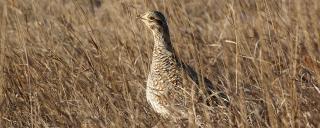
Sharp-tailed Grouse Habitat
General Information
Sharp-tailed grouse have occupied North American prairies for thousands of years and are well adapted to life on the plains. Both sexes are similar; adults are 16-19 inches long and weigh up to about 2 pounds. In spring, males collect on leks (dancing grounds) where they display at dawn and dusk. The exhibition is a ritualized display that establishes territorial boundaries and advertises the location of the lek to females. The lek serves as the focal point for the local population, and most year-round activities occur within a 1-2-mile radius of the lek. One or more dominant males occupy central territories and do most of the breeding. After mating, females nest usually within one mile or so of the lek. Nests are located in residual vegetation in uncultivated areas. Clutch size varies from 10-14 eggs. Populations fluctuate annually depending on weather and available food and cover.
General Habitat Requirements
The sharp-tailed grouse is a plains grassland species with population strongholds in uncultivated areas interspersed with small patches of brush and trees. Sharp-tailed grouse feed on berries, seeds and small grains when available. Young grouse feed mainly on insects, but gradually shift to vegetation. Winter is a time of increased energy demand. Brushy habitat that provides both food and cover is critical at this time. Sharp-tailed grouse burrow in the snow, which enables them to withstand periods of intense winter weather. Sharp-tailed grouse populations are most prevalent where agricultural practices are less intense, grassland is present, and brushy areas occur in draws and river drainages.
Management Considerations
- Delay cutting grasslands (nesting habitat) until after the primary nesting season (April 15 through August 1). Plant mixtures of grasses and forbs in reclaimed croplands, land retirement (CRP), and grassland restoration areas.
- Implement prescribed grazing plans that provide residual vegetation the following spring.
- Use prescribed burning where necessary to control woody vegetation and rejuvenate decadent grass stands.
- Use prescribed grazing plans to eliminate overutilization of woody draws, mesic swales and riparian areas.
- Control noxious weeds to prevent domination of grasslands and rangelands.
- Conscientious use of pesticides (e.g., least toxic to sharp-tailed grouse, use methods to minimize exposure by grouse, minimize negative impacts to desirable habitat, target pests instead of broad scale application, Integrated Pest Management).
- Reduce or eliminate fall tillage that leaves land fallow over winter.
- Preserve and maintain grassland/ forb communities in large (over 40 acres) contiguous tracts by prescribed rotational burning and rotational mowing when and where appropriate.
- Preserve native prairie. It is not recommended to convert native prairie for wildlife food plots, introduced grass species, trees, etc.
- Avoid constructing new fences through or near leks. If fences are located near leks, install visibility markers (vinyl strips, flags, PVC pipe, tape or high-visibility wire) to existing fences.
- Preserve undisturbed grasslands, native rangelands, and other low-growing grassy and shrubby habitats, especially those within one mile of a lek.
- Control tall woody vegetation, including single trees that act as raptor perches and raptor nest sites.
- Use flushing bars, avoid night mowing and cut hay fields from the center outward or toward undisturbed habitat.
